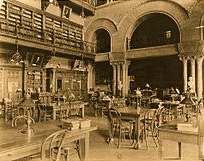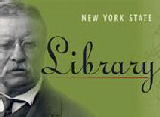New York State Library


A description of what the New York State Library is and who has access, specifically focusing on the collections of full text medical and science journals available through the NYSL.
 The New York State Library is part of the New York State Education Department. The Library and its sister institutions, the New York State Museum and New York State Archives, are housed in the Cultural Education Center. The building is part of the Empire State Plaza, a large complex of state government offices in downtown Albany, New York,United States.
The New York State Library is part of the New York State Education Department. The Library and its sister institutions, the New York State Museum and New York State Archives, are housed in the Cultural Education Center. The building is part of the Empire State Plaza, a large complex of state government offices in downtown Albany, New York,United States.
Research Library
 Library interior late 19th century.
Library interior late 19th century.
The New York State Library was established in 1818 to serve the government of New York State. Although its scope has increased since then, one of the State Library’s primary functions is still to serve as a repository for the official publications of New York State government (the executive, legislative, and judicial branches, as well as the commissions, public authorities, and other agencies). The Library is also a depository for federal government documents.
The New York State Library’s collections have a strong focus on the history and culture of New York State, including extensive holdings in local history and genealogy.
On March 29, 1911, a fire in the Assembly Chamber of the New York State Capitol, where the Library was located at the time, devastated the Library’s collections, destroying approximately 450,000 books and 270,000 manuscripts including some of the historical records documenting New York’s early Dutch and colonial history, translated by Francois Adriaan van der Kemp.
Talking Book and Braille Library
The New York State Library is located in the Cultural Education Center.
The New York State Talking Book and Braille Library (TBBL) is a unit of the New York State Library, but it is also a Regional Library in the nationwide program coordinated by the National Library Service for the Blind and Physically Handicapped, a division of theLibrary of Congress, in Washington DC.
TBBL lends braille and recorded books and magazines, and the necessary equipment to play recorded books, to New York State residents who are unable to read standard printed materials because of a visual or physical disability. TBBL serves residents of the 55 upstate counties of New York State; the Andrew Heiskell Library, a unit within the New York Public Library, serves residents of New York City and Long Island.
History of TBBL
- 1896 — Established the New York State Library for the Blind, providing embossed books to blind adults.
- 1931 — Became one of the original Regional Libraries in the Library of Congress’ national program. “Talking” books on long-playing record were introduced.
- 1952 — Extended Library services to blind children.
- 1966 — Extended Library services to physically disabled and reading disabled individuals.
- 1974 — Renamed the New York State Library for the Blind and Visually Handicapped.
- 1995 — Renamed the New York State Talking Book and Braille Library.
Historical Timeline for the New York State Library
| 1818 | The New York State Library (NYSL) is established, making it only the third state library in the country at the time. (The Ohio and Pennsylvania State Libraries were created in 1817 and 1816, respectively.) Originally located in the State Capitol, NYSL served mainly as a law and reference library for the use of legislators, judges, and state employees. |
|---|---|
| 1844 | NYSL comes under the direction of the New York State Board of Regents, which has broad oversight of education in New York. |
| 1858 | NYSL becomes a Federal Depository. |
| 1871 | NYSL becomes a Federal Patent Depository |
| 1896 | The New York State Legislature appropriates money to create a Library for the Blind, which provides embossed books to blind adults. |
| 1888 | Melvil Dewey (creator of the Dewey Decimal System for classifying books) is appointed Director of the State Library, a position he holds through 1906. |
| 1904 | NYSL becomes part of the newly-formed NYS Education Department. |
| 1911 | A fire in the Capitol destroys a large part of the State Library’s collections on March 29, just weeks before the Library was to move from the Capitol to the newly-constructed Education Building. |
| 1913 | NYSL reopens in the Education Building. |
| 1931 | The Library for the Blind becomes one of the original Regional Libraries in the Library of Congress’ national program. “Talking” books on long-playing record are introduced. (1934?) |
| 1974 | The Library for the Blind is renamed the Library for the Blind and Visually Handicapped. |
| 1978 | The Library moves into the new Cultural Education Center (part of the Empire State Plaza), which also houses the State Museum and the State Archives.NYSL converts to an automated catalog. |
| 1987 | The New York State Newspaper Project is established. |
| 1994 | NYSL launches its first web siteThe NYS Government Information Locator System (GILS) is established. |
| 1995 | The Library for the Blind and Visually Handicapped is renamed the Talking Book and Braille Library. |


